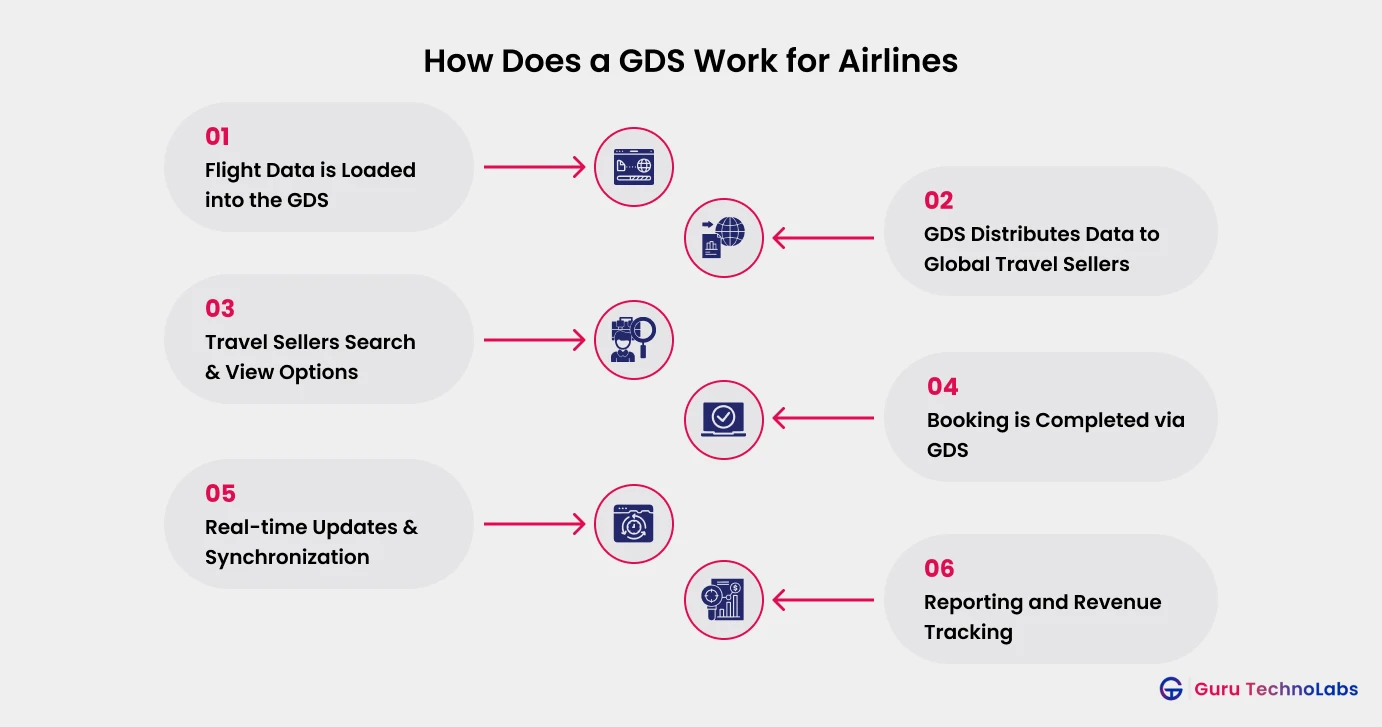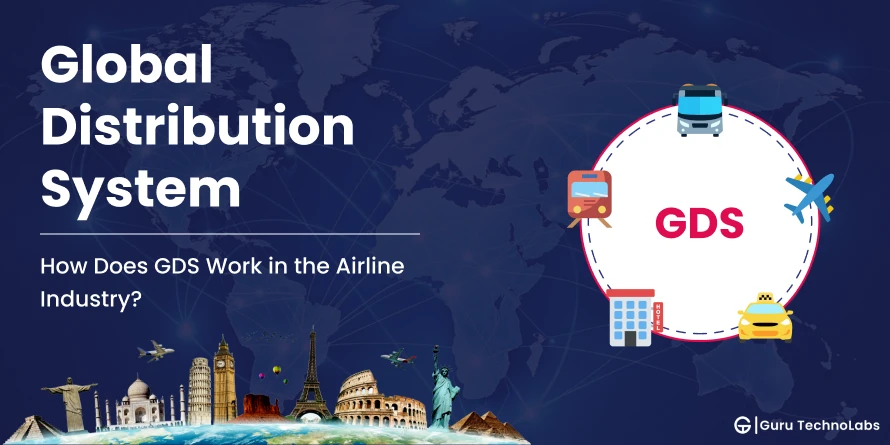In the fast-paced world of air travel, where pricing, schedules, and availability shift by the minute, efficiency and global reach are everything. To stay competitive and visible in a market filled with thousands of routes and fare combinations, airlines rely on powerful digital tools to connect with travel agents, corporations, and booking platforms worldwide.
One of the most critical systems enabling this level of access and automation is the Global Distribution System (GDS).
Originally developed to help airlines manage seat inventory and streamline reservations, GDS has evolved into a core engine of airline distribution. It acts as a centralized platform where flight schedules, pricing, seat availability, and booking rules are published and distributed to thousands of travel sellers globally.
For airlines, this means tapping into new markets, selling through multiple channels simultaneously, and managing bookings in real-time, all through a single, integrated system.
What is a Global Distribution System (GDS) in the Airline Industry?
Global Distribution System (GDS) is a computerized platform that connects airlines, travel agencies, hotels, and other travel service providers, enabling real-time access to flight schedules, seat availability, pricing, and booking capabilities.
GDS platforms streamline the reservation process, allowing travel agents and online travel agencies to efficiently search, compare, and book travel services for their clients.
Interesting Things to Know
The global GDS market is valued at approximately $6.2 billion in 2025, with steady growth estimated as online travel booking and demand for personalized experiences increase.
Aviation is the largest application segment in the GDS market, underscoring its critical role in connecting travelers globally.
The GDS industry is dominated by major players such as Sabre, Amedeus, and Travelport, which collectively connect around 400 airlines and thousands of travel agencies across the world.
For instance, Emirates Airlines uses GDS to make its flight content accessible to travel agencies globally. Through a multi-year global distribution agreement with Sabre, Emirates provides travel buyers and agencies immediate access to its flight schedules, fares, and availability in Sabre’s GDS platform, including New Distribution Capability (NDC) offers that enhance booking flexibility and personalization.
This partnership helps Emirates reach a vast network of travel agencies and customers across more than 45 markets, ensuring its flights are visible and bookable globally.
Why is GDS Important for Airlines Today?
In today’s fast-paced travel economy, airlines rely on GDS to streamline operations, reach global travelers, and optimize revenue. If you are wondering what GDS is in the airline industry, and why it still matters, let’s break it down with real benefits that reflect today’s market needs.
Broader Distribution Reach
GDS in airlines helps carriers connect with travel agents, OTAs, and corporate booking tools globally, expanding their visibility far beyond their website or mobile app.
Real-time Inventory and Pricing
By syncing the flight schedules, seat availability, and dynamic pricing instantly, GDS platforms allow airlines to push accurate data across all sales channels, reducing errors and missed bookings.
Streamlined Travel Agency Bookings
One of the key benefits of GDS in the airline industry is its integration with hundreds of travel agencies globally, making it easier for agents to find, book, and manage flights quickly.
Strong Corporate Travel Partnerships
GDS in airlines is essential for capturing business travel bookings, which often come through managed travel programs requiring GDS integration for compliance and reporting.
Competitive Advantage Through Data
Airlines gain access to rich booking data and analytics via the GDS platforms, helping them analyze trends, adjust pricing strategies, and stay ahead in a highly competitive market.
How Does a GDS Work for Airlines? (Step-by-Step Process)
Now that we understand what GDS is, let’s look at how it works for airlines.
For airlines, a Global Distribution System (GDS) functions as a centralized platform that automates the distribution of flight inventory to travel sellers around the world. It handles everything from fare publishing to real-time booking and seat management – all through a single interface that connects airlines with global travel demand.
Here’s how the system works in a step-by-step process:

Step 1: Flight Data is Loaded into the GDS
Airlines input their flight schedules, routes, pricing, fare classes, and seat availability into the GDS via a central reservation system or API integration.
Step 2: GDS Distributes Data to Global Travel Sellers
The GDS pushes this data to connected travel agents, OTAs (Online Travel Agencies), and corporate travel platforms, making the airline’s flights visible across the globe.
Step 3: Travel Sellers Search & View Options
Travel agents or platforms search for flights based on customer needs. The GDS returns results showing multiple airlines, allowing comparison by fare, schedule, route, and services.
Step 4: Booking is Completed via GDS
When a flight is selected, the booking is processed in real time through the GDS. The system reserves the seat, confirms the fare, and generates the Passenger Name Record (PNR).
Step 5: Real-time Updates & Synchronization
Inventory is updated immediately, ensuring seat counts are accurate and pricing reflects any changes, like last-minute fare adjustments or cancellations.
Step 6: Reporting and Revenue Tracking
Airlines receive detailed reports from the GDS for accounting, reconciliation, and market analysis. This helps track which channels and routes are driving bookings.
Through this seamless digital pipeline, GDS allows airlines to scale distribution, reduce manual intervention, and reach markets they might otherwise miss, especially in corporate and international segments.
GDS vs Direct Booking: What’s Better for Airlines?
When it comes to selling flight tickets, airlines typically rely on two main distribution channels: Global Distribution System (GDS) and direct bookings through their websites or apps. While both serve the same ultimate purpose – ticket sales – they differ significantly in terms of audience reach, control, and cost structure.
| Aspect | GDS (Global Distribution System) | Direct Booking |
|---|---|---|
| Distribution Reach | Wide global reach via travel agents and OTAs | Limited to users who visit the airline’s website/app |
| Target Audience | Corporate travelers, international markets, and travel agencies | Leisure travelers, loyal customers, and mobile users |
| Control Over Branding | Limited (controlled by third-party platforms) | Full control over branding and customer experience |
| Revenue and Costs | Involves commission and distribution fees/td> | Higher margins, no third-party fees |
| Customer Data Access | Minimal or indirect | Full access to customer data for loyalty & marketing |
| Booking Flexibility | Multi-airline itinerary booking, ideal for agents | Direct flight booking only |
| Technical Investment | Managed by GDS providers | Requires investment in website, app, and backend |
In summary, GDS is ideal for broader distribution and accessing high-volume channels like corporate travel, while direct booking is best for brand-driven, cost-effective customer engagement.
Most successful airlines use a hybrid strategy, leveraging the strengths of both channels to maximize visibility and revenue.
You May Also Like
Benefits of GDS
Challenges of GDS for Airlines
While Global Distribution Systems (GDS) have revolutionized the airline industry, they also come up with a unique set of challenges. Airline must navigate these obstacles to stay competitive and ensure a seamless experience for their customers.
- High Distribution Cost: High distribution fees, which are paid to third-party intermediaries, can significantly eat into an airline’s profits, especially for smaller carriers.
- Limited Control Over Customer Experience: GDS systems, while efficient, often limit airlines’ ability to control the customer experience. With third-party distributors handling bookings, airlines have fewer opportunities to personalize or influence the customer journey directly.
- Data Ownership and Access Issues: GDS platforms control much of the booking data, which can hinder an airline’s ability to gain real-time insights and analyze customer behavior effectively. This lack of direct access to valuable data can restrict strategic decision-making.
- Legacy System Dependencies: Many GDS systems are built on older technology, which can create compatibility issues for airlines looking to modernize their operations. Relying on outdated infrastructure can result in inefficiencies and higher operational costs.
- Lack of Differentiation: GDS platforms often present airlines’ offerings in a standardized format, making it difficult for carriers to stand out. This lack of differentiation can hurt an airline’s ability to showcase its unique services and brand identity to travelers.
- Compliance and Regulatory Constraints: Airlines must navigate a complex web of global regulations when using GDS. Compliance with these rules, along with the ever-evolving legal landscape, can add operational complexity and increase the risk of non-compliance fines.
The Future of GDS in the Airline Industry
GDS continues to play a vital role in expanding an airline’s market reach by connecting flight inventory to a global network of travel agents and booking platforms. As the industry shifts toward personalized offers, real-time pricing, and smarter distribution through technologies like NDC, the future of GDS lies in enhanced flexibility and deeper integration.
At Guru TechnoLabs, we build custom travel solutions that help airlines and travel businesses seamlessly integrate with major GDS providers, Our GDS Integration Service empowers you to stay competitive, reach more customers, and scale faster in a digital-first world.










